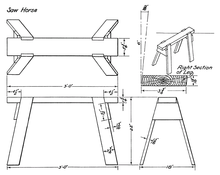


In woodworking, a saw-horse or sawhorse (saw-buck, trestle, buck)[1] is a trestle structure used to support a board or plank for sawing. A pair of sawhorses can support a plank, forming a scaffold.[2] In certain circles, it is also known as a mule and a short sawhorse is known as a pony. The names come from the shape of the frame, which resembles a horse.[3] A sawhorse may also be a rack for supporting logs for sawing, known in the US as a sawbuck.
The sawhorse may be designed to fold for storage. A sawhorse with a wide top is particularly useful to support a board for sawing or as a field workbench, and is more useful as a single, but also more difficult to store.
A sawhorse can also be used as the base for a portable work table by placing a sheet of plywood or even a door across two sawhorses. If the sawhorses are strong enough, the portable table can be used as a platform for tools like a table saw, although with caution if the top is not secured to the sawhorses.
In boatmaking, the curved nature of the cross-beam, designed to support the timbers used for hulls led to the colloquial name of sea-horse, this term, derived from old Norse, entered the Northumbrian dialect, it is thought, through Norwegian settlers as early as the 14th century.